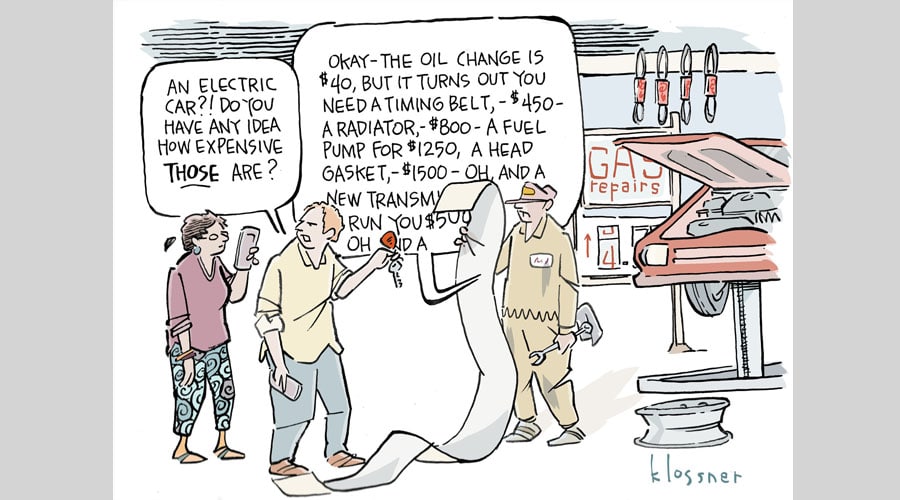As the train of new electric vehicle models, news headlines, and technological innovations continues to pick up steam, it’s worth checking in on an important question: is it cheaper to go electric or gas-powered? If you look at sticker price alone, you’ll find that EVs are consistently more expensive than their gas-powered counterparts. But whether you’re buying an EV or a gas-powered car, the purchase price is only a portion of the total lifetime cost of owning that vehicle. To understand the full cost of owning any vehicle, you’ve got to consider the additional expenses, such as registrations and insurance, plus operating costs, such as fuel (or charging), maintenance and repairs.
According to a recent study from Consumer Reports, owning an electric vehicle will actually save money over the life of the vehicle, which is great news for consumers (and for our collective future). And the savings can be substantial. In the study, Consumer Reports found that for the typical EV owner, the savings over the life of the EV would range from $6,000 to $10,000.
Owning an electric vehicle will actually save money over the life of the vehicle, which is great news for consumers and our collective future. And the savings can be substantial.
How does the math pan out? Here’s part of it: thanks to a range of federal and state tax credits and rebates currently available, when you buy a new EV, the actual purchase price can end up much lower if you take advantage of these incentives. For example, right now the federal electric vehicle tax credit can save buyers $7,500 off the price of many new vehicles. And depending on where you live, your state may also offer additional tax credits or rebates. Even some energy utility companies are offering discounts and other incentives to encourage more people to switch to EVs.
On top of this, EVs also save big on the long list of maintenance items that you no longer have to pay for, such as timing belts, fuel pumps, radiators, head gaskets, and those super fun oil changes—all only necessary for internal combustion engines. Consumer Reports says that EV owners spend half as much to repair and maintain their vehicles.
And “fueling” the vehicles is another huge source of savings. Charging an EV still comes with a cost, especially if you rely on public charging stations rather than charging at home, but according to the Consumer Reports (CR) analysis, the average EV driver will spend 60% less to power their vehicle than they would for a gas-powered car. CR reports that the average residential electricity rate in the U.S. is roughly 13 cents per kilowatt-hour, which translates into $1.16 per “eGallon,” which is the Department of Energy’s term for the electric equivalent of gasoline. This, of course, would vary based on where you live in the U.S. and the changing cost of gasoline, but with the average cost of a gallon of gasoline over $3.00, powering an EV costs less than a third the cost of fueling a gas-powered car.
Getting personal about it
If you’re considering an EV of your own, your ‘cost of ownership’ equation will vary depending on which EV you want to buy, where exactly you live, how much you pay for electricity, fuel costs in your area, whether you’d install a home charge or not, and of course, which incentives like tax credits are available to you.
EVs also save big on the long list of maintenance items that you no longer have to pay for, such as timing belts, fuel pumps, radiators, head gaskets, and those super fun oil changes.
Thankfully, there are some useful resources to help you dig into these factors. Plugstar.com will help you sort through all of the different models of EVs and plug-in hybrids currently available. To find out what tax credits and rebates you may be able to get, put in your zipcode here to find out incentives available in your state. On the federal level, the current federal tax credits only apply to the first 200,000 units sold by each automaker, so you can check the latest numbers to determine if an EV qualifies for the tax credit. And this useful tool from the Department of Energy helps you compare the overall costs of multiple vehicles at once based on your own annual driving habits.
So, what’s the bottom line? Is it cheaper to drive a battery-powered electric vehicle or a gas-powered internal combustion engine? While there are a lot of inputs to plug into your personal calculation, EVs are now coming out ahead, especially in more affordable car types. Just as solar panels can make your home more valuable even with a higher up-front cost, the lifetime savings of owning an EV more than makes up for the higher sticker price. And as battery technology increases, costs come down, and more and more EVs hit the market, we can expect this trend to continue. This is great news for all of us interested in a healthier, safer, clean energy future.















